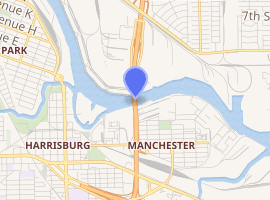Sidney Sherman Bridge
The Sidney Sherman Bridge is a strutted girder bridge in Houston, Texas. It spans the Houston Ship Channel (Buffalo Bayou) and carries the East Loop segment of Interstate 610 on the east side of the city. It is more popularly known as the 610 Bridge or The Ship Channel Bridge.
Sidney Sherman Bridge | |
|---|---|
| Coordinates | 29.725086°N 95.266421°W |
| Carries | 10 general purpose lanes of |
| Crosses | Houston Ship Channel/Buffalo Bayou |
| Locale | Houston, Texas |
| Official name | Sidney Sherman Bridge |
| Maintained by | Texas Department of Transportation |
| Characteristics | |
| Design | strutted girder |
| Width | 46 m (152 ft) |
| Longest span | 183 m (600 ft) |
| Clearance above | 41 m (135 ft) |
| History | |
| Opened | March 2, 1973 |
| Statistics | |
| Toll | none |

| |
History
Construction on the bridge was on the planning boards by the Texas Department of Transportation dating as far back as 1962. Originally planned with a 400 foot (120 m) mainspan, it was rejected by the Army Corps of Engineers for fear that the narrow mainspan was a hazard to ships on the Ship Channel. So a 600 foot (180 m) mainspan was in the plans instead, and the Army Corps approved of the design. Construction on the bridge started in 1969, and was opened to traffic on March 2, 1973 (along with the East Loop of I-610). Just a year before, the National Society of Professional Engineers named the new bridge one of the top ten outstanding engineering achievements in the nation. In 1974, it was renamed the Sidney Sherman Bridge after Sidney Sherman who led the Texas Revolution and took part in making the Houston Ship Channel good for navigation.
Controversy
The bridge clearance is 135 feet (41 m), which some officials have deemed too low for ships to navigate.[1] By the time the V-struts supporting the mainspan were put in place, the Port of Houston claimed the struts were an even more dangerous hazard to ships that must veer from the middle of the waterway. By some accounts, port officials protested, but TxDOT did not listen to their pleas. The bridge cost TxDOT $19 million in its current configuration; a higher clearance would have cost more, and the agency went on to investigate that ships did not need a 120 foot (37 m) clearance. This decision proved to be a mistake. Several ships have collided with the bridge over a period of 27 years, but despite this the bridge only suffered minor damage and was still intact. That all changed in December 2000 when a cargo crane struck the bridge, knocking a hole in the concrete deck and damaging a steel beam. The damage took six weeks to repair, forcing several lanes to be closed in the process.[2] However, the worst accident happened in May 2001 when a freighter's cargo boom caused severe damage to a girder and put another gaping hole in the span. Several lanes of the bridge were closed for two months while repairs were completed.
References
- Slotboom, Erik (2003). "Bridges and Tunnels". Houston Freeways: A Historical and Visual Journey (PDF). Archived from the original (PDF) on September 27, 2007. Retrieved September 4, 2018.
- TexasFreeway > Houston > Photo Gallery > IH 610 > Excluding the West Loop